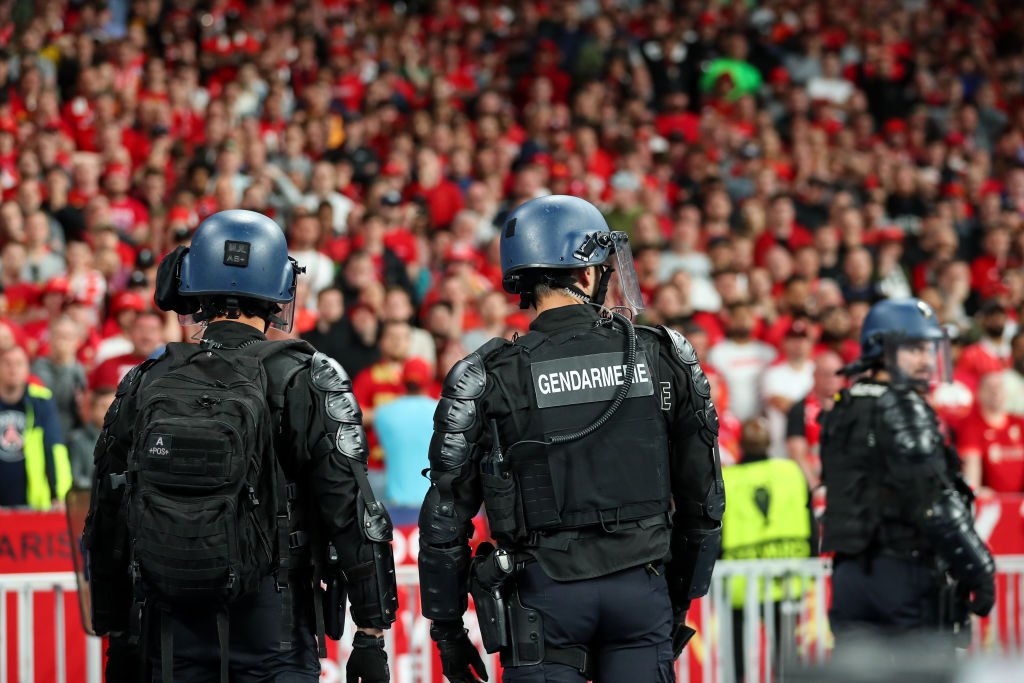UEFA has published its independent review into the chaotic Champions League final last May and it is brutally honest in admitting its own failings. The events in and around the Stade de France as Liverpool played Real Madrid in European football’s showpiece event made global headlines for all the wrong reasons. Television pictures of French police teargassing supporters, including children, were beamed around the world and caused a political furore in Paris.
The government, notably the Interior Minister Gérald Darmanin and the Minister of Sports, Amélie Oudea-Castera, initially blamed English fans for the trouble, a position they maintained for weeks until the accumulation of evidence elicited what can best be described as a reluctant and half apology from Darmanin.
Monday’s report absolves English and Spanish supporters from any blame, and described the French government’s attempt to smear fans as ‘reprehensible’.
‘Crack hill’ is the name of a notorious area in northern Paris where migrants cohabit with crack addicts in squalid tented camps
It also states that UEFA bears ‘primary responsibility’ for the disastrous logistical and safety failures that turned the evening of May 28 into a shambles. The Paris Préfecture de Police and the French Football Federation (FFF) are also criticised in the report, which was headed by Tiago Brandão Rodrigues, a former education minister in Portugal.
The 220-page report is to be commended for its honesty, were it not for one omission. Throughout, the young men who robbed, attacked and sexually assaulted visiting fans are referred to as ‘locals’, a description that is repeated in the British media reports this morning.
The police, for example, are criticised for having no effective plan ‘to deal with anti-social behaviour or violence perpetrated by locals.’ There are descriptions of ‘arriving supporters being attacked and mugged, or pickpocketed… and further accounts of locals attacking supporters as they left the stadium.’
While it was true some of the people who tried to enter the stadium without a ticket were locals, it appears that the majority of the crimes committed against supporters were by migrants. On the Tuesday after the match several appeared in court, watched by a reporter from the local paper, Le Parisien. ‘They contrast with the profiles of delinquents sketched by the authorities,’ said the paper. ‘They are often economic migrants, without papers, of very diverse origins, far from the young people from the housing estates described by the police prefecture.’
Among those in court were three Peruvians, in ‘an irregular situation”, aged 21, 26 and 39, caught in possession of 14 stolen phones; a 24-year-old Algerian, with similar status, who stole the mobile phone of a Liverpool fan, and a 34-year-old Palestinian man who ripped off the ‘necklace of a British victim, bit the arm of a person who tried to intercept him, and hit a police officer while in custody.’
In the July issue of Causeur, a conservative magazine, the fiasco of the Stade de France was examined in an article entitled ‘The Denial of Saint-Denis’. Erwan Guermeur, a police union spokesman for Seine-Saint-Denis, said that ‘the majority of the attacks [against fans] were committed by migrants’, a view reiterated by Claude Morel, a former local government official in Seine-Saint-Denis. ‘It was mostly a matter of opportunistic crime, a golden opportunity, which caused migrants to move from “Crack Hill” to prey on the supporters,’ he said.
‘Crack hill’ is the name of a notorious area in northern Paris where migrants cohabit with crack addicts in squalid tented camps. It’s only two miles from the Stade de France, so in a sense its inhabitants are indeed locals.
The UEFA report mentions that ‘300 to 400 young people from sensitive neighbourhoods in Seine-Saint-Denis… were also part of the problem.’
It didn’t elaborate. UEFA took these numbers from Didier Lallement, the chief of the Paris police on the evening of the final, when he was questioned at a Senate hearing a fortnight later. ‘There were 300 to 400 people who did not seem to be supporters,’ he explained. ‘I don’t know if they were from Seine-Saint-Denis or not. I have to be careful about what I suspect.’ But Lallement did acknowledge that among the troublemakers ‘were unaccompanied minors’.
In France ‘sensitive neighbourhoods’ and ‘unaccompanied minors’ have in polite society become part of the migrant lexicon, a way of referring to the migrant crisis without explicitly mentioning it. Furthermore in France, as in Britain, the government has a habit of housing illegal immigrants, either in temporary or permanent accommodation, in the poorest areas, which leads not only to social tensions but also a decline in public services.
Two days after the Champions League final, Stéphane Troussel, the Socialist president of the Seine-Saint-Denis department, expressed his anger at Marine Le Pen’s National Rally for blaming local thugs for causing the trouble. He should be indignant this morning because once again the inhabitants of Seine-Saint-Denis have been made the scapegoats.







Comments